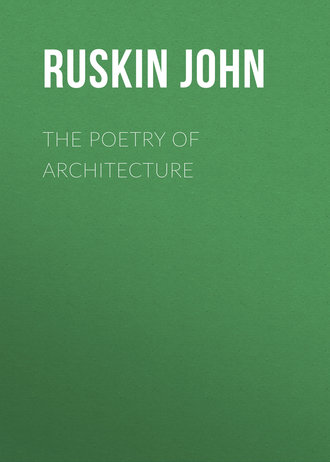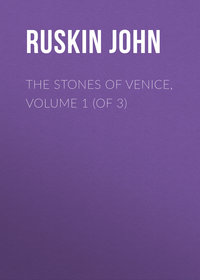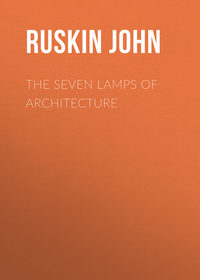 полная версия
полная версияThe Poetry of Architecture
78. Secondly, that this inconspicuousness is to be obtained, not by adhering to any model of simplicity, but by taking especial care that the lines of the chimney are no interruption, and its color no contrast, to those of the building to which it belongs. Thus Figs. h to m would be far more actually remarkable in their natural situation, if they were more simple in their form; for they would interrupt the character of the rich architecture by which they are surrounded. Fig. d, rising as it does above an old Gothic window, would have attracted instant attention, had it not been for the occurrence of the same lines in it which prevail beneath it. The form of n only assimilates it more closely with the roof on which it stands. But we must not imitate chimneys of this kind, for their excellence consists only in their agreement with other details, separated from which they would be objectionable; we can only follow the principle of the design, which appears, from all that we have advanced, to be this: we require, in a good chimney, the character of the building to which it belongs divested of all its elevation, and its prevailing lines, deprived of all their ornament.
79. This it is, no doubt, excessively difficult to give; and, in consequence, there are very few cities or edifices in which the chimneys are not objectionable. We must not, therefore, omit to notice the fulfillment of our expectations, founded on English character. The only two chimneys fit for imitation, in the whole eighteen, are English; and we would not infer anything from this, tending to invalidate the position formerly advanced, that there was no taste in England; but we would adduce it as a farther illustration of the rule, that what is most adapted to its purpose is most beautiful. For that we have no taste, even in chimneys, is sufficiently proved by the roof effects, even of the most ancient, unaffected, and unplastered of our streets, in which the chimneys, instead of assisting in the composition of the groups of roofs, stand out in staring masses of scarlet and black, with foxes and cocks whisking about, like so many little black devils, in the smoke on the top of them, interrupting all repose, annihilating all dignity, and awaking every possible conception which would be picturesque, and every imagination which would be rapturous, to the mind of master-sweeps.
80. On the other hand, though they have not on the Continent the same knowledge of the use and beauty of chimneys in the abstract, they display their usual good taste in grouping, or concealing them; and, whether we find them mingling with the fantastic domiciles of the German, with the rich imaginations of the Spaniard, with the classical remains and creations of the Italian, they are never intrusive or disagreeable; and either assist the grouping, and relieve the horizontality of the lines of the roof, or remain entirely unnoticed and insignificant, smoking their pipes in peace.
81. It is utterly impossible to give rules for the attainment of these effects, since they are the result of a feeling of the proportion and relation of lines, which, if not natural to a person, cannot be acquired, but by long practice and close observation; and it presupposes a power rarely bestowed on an English architect, of setting regularity at defiance, and sometimes comfort out of the question. We could give some particular examples of this grouping; but, as this paper has already swelled to an unusual length, we shall defer them until we come to the consideration of street effects in general. Of the chimney in the abstract, we are afraid we have only said enough to illustrate, without removing, the difficulty of designing it; but we cannot but think that the general principles which have been deduced, if carefully followed out, would be found useful, if not for the attainment of excellence, at least for the prevention of barbarism.
Oxford, Feb. 10, [1838].
VI.
THE COTTAGE—CONCLUDING REMARKS
"Nunquam aliud Natura, aliud Sapientia, dicit."—Juvenal xiv. 32182. It now only remains for us to conclude the subject of the cottage, by a few general remarks on the just application of modern buildings to adorn or vivify natural scenery.
There are, we think, only three cases in which the cottage is considered as an element of architectural, or any other kind of beauty, since it is ordinarily raised by the peasant where he likes, and how he likes; and, therefore, as we have seen, frequently in good taste.
83. I. When a nobleman, or man of fortune, amuses himself with superintending the erection of the domiciles of his domestics. II. When ornamental summer-houses, or mimicries of wigwams, are to be erected as ornamental adjuncts to a prospect which the owner has done all he can to spoil, that it may be worthy of the honor of having him to look at it. III. When the landlord exercises a certain degree of influence over the cottages of his tenants, or the improvements of the neighboring village, so as to induce such a tone of feeling in the new erections as he may think suitable to the situation.
84. In the first of these cases, there is little to be said; for the habitation of the domestic is generally a dependent feature of his master's, and, therefore, to be considered as a part of it. Porters' lodges are also dependent upon, and to be regulated by, the style of the architecture to which they are attached; and they are generally well managed in England, properly united with the gate, and adding to the effect of the entrance.
In the second case, as the act is in itself a barbarism, it would be useless to consider what would be the best mode of perpetrating it.
In the third case, we think it will be useful to apply a few general principles, deduced from positions formerly advanced.
85. All buildings are, of course, to be considered in connection with the country in which they are to be raised. Now, all landscape must possess one out of four distinct characters.
It must be either woody, the green country; cultivated, the blue country; wild, the gray country; or hilly, the brown country.
I. The Woody, or green, Country. By this is to be understood the mixture of park, pasture, and variegated forest, which is only to be seen in temperate climates, and in those parts of a kingdom which have not often changed proprietors, but have remained in unproductive beauty (or at least, furnishing timber only), the garden of the wealthier population. It is to be seen in no other country, perhaps, so well as in England. In other districts, we find extensive masses of black forest, but not the mixture of sunny glade, and various foliage, and dewy sward, which we meet with in the richer park districts of England. This kind of country is always surgy, oceanic, and massy, in its outline: it never affords blue distances, unless seen from a height; and, even then, the nearer groups are large, and draw away the attention from the background. The under soil is kept cool by the shade, and its vegetation rich; so that the prevailing color, except for a few days at the fall of the leaf, is a fresh green. A good example of this kind of country is the view from Richmond Hill.
86. Now, first, let us consider what sort of feeling this green country excites; and, in order to do so, be it observed, that anything which is apparently enduring and unchangeable gives us an impression rather of future, than of past, duration of existence; but anything which being perishable, and from its nature subject to change, has yet existed to a great age, gives us an impression of antiquity, though, of course, none of stability. A mountain, for instance (not geologically speaking, for then the furrows on its brow give it age as visible as was ever wrinkled on human forehead, but considering it as it appears to ordinary eyes), appears to be beyond the influence of change: it does not put us in mind of its past existence, by showing us any of the effect of time upon itself; we do not feel that it is old, because it is not approaching any kind of death; it is a mass of unsentient undecaying matter, which, if we think about it, we discover must have existed for some time, but which does not tell this fact to our feelings, or, rather, which tells us of no time at which it came into existence; and therefore, gives us no standard by which to measure its age, which, unless measured, cannot be distinctly felt. But a very old forest tree is a thing subject to the same laws of nature as ourselves: it is an energetic being, liable to an approaching death; its age is written on every spray; and, because we see it is susceptible of life and annihilation, like our own, we imagine it must be capable of the same feelings, and possess the same faculties, and, above all others, memory: it is always telling us about the past, never pointing to the future; we appeal to it, as to a thing which has seen and felt during a life similar to our own, though of ten times its duration, and therefore receive from it a perpetual impression of antiquity. So again a ruined town gives us an impression of antiquity; the stones of which it is built, none; for their age is not written upon them.
87. This being the case, it is evident that the chief feeling induced by woody country is one of reverence for its antiquity. There is a quiet melancholy about the decay of the patriarchal trunks, which is enhanced by the green and elastic vigor of the young saplings; the noble form of the forest aisles, and the subdued light which penetrates their entangled boughs, combine to add to the impression; and the whole character of the scene is calculated to excite conservative feeling. The man who could remain a radical in a wood country is a disgrace to his species.
88. Now, this feeling of mixed melancholy and veneration is the one of all others which the modern cottage must not be allowed to violate. It may be fantastic or rich in detail; for the one character will make it look old-fashioned, and the other will assimilate with the intertwining of leaf and bough around it: but it must not be spruce, or natty, or very bright in color; and the older it looks the better.
A little grotesqueness in form is the more allowable, because the imagination is naturally active in the obscure and indefinite daylight of wood scenery; conjures up innumerable beings, of every size and shape, to people its alleys and smile through its thickets; and is by no means displeased to find some of its inventions half-realized in a decorated panel or grinning extremity of a rafter.
89. These characters being kept in view, as objects to be attained, the remaining considerations are technical.
For the form. Select any well-grown group of the tree which prevails most near the proposed site of the cottage. Its summit will be a rounded mass. Take the three principal points of its curve: namely, its apex and the two points where it unites itself with neighboring masses. Strike a circle through these three points; and the angle contained in the segment cut off by a line joining the two lower points is to be the angle of the cottage roof. (Of course we are not thinking of interior convenience: the architect must establish his mode of beauty first, and then approach it as nearly as he can.) This angle will generally be very obtuse; and this is one reason why the Swiss cottage is always beautiful when it is set among walnut or chestnut trees. Its obtuse roof is just about the true angle. With pines or larches, the angle should not be regulated by the form of the tree, but by the slope of the branches. The building itself should be low and long, so that, if possible, it may not be seen all at once, but may be partially concealed by trunks or leafage at various distances.
90. For the color, that of wood is always beautiful. If the wood of the near trees be used, so much the better; but the timbers should be rough-hewn, and allowed to get weather-stained. Cold colors will not suit with green; and, therefore, slated roofs are disagreeable, unless, as in the Westmoreland cottage, the gray roof is warmed with lichenous vegetation, when it will do well with anything; but thatch is better. If the building be not of wood, the walls may be built of anything which will give them a quiet and unobtruding warmth of tone. White, if in shade, is sometimes allowable; but, if visible at any point more than 200 yards off, it will spoil the whole landscape. In general, as we saw before, the building will bear some fantastic finishing, that is, if it be entangled in forest; but, if among massive groups of trees, separated by smooth sward, it must be kept simple.
91. II. The Cultivated, or blue, Country. This is the rich champaign land, in which large trees are more sparingly scattered, and which is chiefly devoted to the purposes of agriculture. In this we are perpetually getting blue distances from the slightest elevation, which are rendered more decidedly so by their contrast with warm corn or plowed fields in the foreground. Such is the greater part of England. The view from the hills of Malvern is a good example. In districts of this kind, all is change; one year's crop has no memory of its predecessor; all is activity, prosperity, and usefulness: nothing is left to the imagination; there is no obscurity, no poetry, no nonsense: the colors of the landscape are bright and varied; it is thickly populated, and glowing with animal life. Here, then, the character of the cottage must be cheerfulness; its colors may be vivid: white is always beautiful; even red tiles are allowable, and red bricks endurable. Neatness will not spoil it: the angle of its roof may be acute, its windows sparkling, and its roses red and abundant; but it must not be ornamented nor fantastic, it must be evidently built for the uses of common life, and have a matter-of-fact business-like air about it. Its outhouses and pigsties, and dunghills should therefore, be kept in sight: the latter may be made very pretty objects, by twisting them with the pitchfork, and plaiting them into braids, as the Swiss do.
92. III. The Wild, or gray, Country. "Wild" is not exactly a correct epithet; we mean wide, uninclosed, treeless undulations of land, whether cultivated or not. The greater part of northern France, though well brought under the plow, would come under the denomination of gray country. Occasional masses of monotonous forest do not destroy this character. Here, size is desirable, and massiness of form; but we must have no brightness of color in the cottage, otherwise it would draw the eye to it at three miles off, and the whole landscape would be covered with conspicuous dots. White is agreeable, if sobered down; slate allowable on the roof as well as thatch. For the rest, we need only refer to the remarks made on the propriety of the French cottage.
93. Lastly, Hill, or brown, Country. And here if we look to England alone, as peculiarly a cottage country, the remarks formerly advanced, in the consideration of the Westmoreland cottage, are sufficient; but if we go into mountain districts of more varied character, we shall find a difference existing between every range of hills, which will demand a corresponding difference in the style of their cottages. The principles, however, are the same in all situations, and it would be a hopeless task to endeavor to give more than general principles. In hill country, however, another question is introduced, whose investigation is peculiarly necessary in cases in which the ground has inequality of surface, that of position. And the difficulty here is, not so much to ascertain where the building ought to be, as to put it there, without suggesting any inquiry as to the mode in which it got there; to prevent its just application from appearing artificial. But we cannot enter into this inquiry, before laying down a number of principles of composition, which are applicable, not only to cottages, but generally; and which we cannot deduce until we come to the consideration of buildings in groups.
94. Such are the great divisions under which country and rural buildings may be comprehended; but there are intermediate conditions, in which modified forms of the cottage are applicable; and it frequently happens that country which, considered in the abstract, would fall under one of these classes, possesses, owing to its peculiar climate or associations, a very different character. Italy, for instance, is blue country; yet it has not the least resemblance to English blue country. We have paid particular attention to wood; first, because we had not, in any previous paper, considered what was beautiful in a forest cottage; and secondly, because in such districts there is generally much more influence exercised by proprietors over their tenantry, than in populous and cultivated districts; and our English park scenery, though exquisitely beautiful, is sometimes, we think, a little monotonous, from the want of this very feature.
95. And now, farewell to the cottage, and, with it, to the humility of natural scenery. We are sorry to leave it; not that we have any idea of living in a cottage, as a comfortable thing; not that we prefer mud to marble, or deal to mahogany; but that, with it, we leave much of what is most beautiful of earth, the low and bee-inhabited scenery, which is full of quiet and prideless emotion, of such calmness as we can imagine prevailing over our earth when it was new in heaven. We are going into higher walks of architecture, where we shall find a less close connection established between the building and the soil on which it stands, or the air with which it is surrounded, but a closer connection with the character of its inhabitant. We shall have less to do with natural feeling, and more with human passion; we are coming out of stillness into turbulence, out of seclusion into the multitude, out of the wilderness into the world.
PART II.
The Villa
I.
THE MOUNTAIN VILLA—LAGO DI COMO
96. In all arts or sciences, before we can determine what is just or beautiful in a group, we must ascertain what is desirable in the parts which compose it, separately considered; and therefore it will be most advantageous in the present case, to keep out of the village and the city, until we have searched hill and dale for examples of isolated buildings. This mode of considering the subject is also agreeable to the feelings, as the transition from the higher orders of solitary edifices, to groups of associated edifices, is not so sudden or startling, as that from nature's most humble peace, to man's most turbulent pride.
We have contemplated the rural dwelling of the peasant; let us next consider the ruralized domicile of the gentleman: and here, as before, we shall first determine what is theoretically beautiful, and then observe how far our expectations are fulfilled in individual buildings. But a few preliminary observations are necessary.
97. Man, the peasant, is a being of more marked national character, than man, the educated and refined. For nationality is founded, in a great degree, on prejudices and feelings inculcated and aroused in youth, which grow inveterate in the mind as long as its views are confined to the place of its birth; its ideas molded by the customs of its country, and its conversation limited to a circle composed of individuals of habits and feelings like its own; but which are gradually softened down, and eradicated, when the mind is led into general views of things, when it is guided by reflection instead of habit, and has begun to lay aside opinions contracted under the influence of association and prepossession, substituting in their room philosophical deductions from the calm contemplation of the various tempers, and thoughts, and customs, of mankind. The love of its country will remain with undiminished strength in the cultivated mind, but the national modes of thinking will vanish from the disciplined intellect.
98. Now as it is only by these mannerisms of thought that architecture is affected, we shall find that, the more polished the mind of its designer, the less national will be the building; for its architect will be led away by a search after a model of ideal beauty, and will not be involuntarily guided by deep-rooted feelings, governing irresistibly his heart and hand. He will therefore be in perpetual danger of forgetting the necessary unison of scene and climate, and, following up the chase of the ideal, will neglect the beauty of the natural; an error which he could not commit, were he less general in his views, for then the prejudices to which he would be subject, would be as truly in unison with the objects which created them, as answering notes with the chords which awaken them. We must not, therefore, be surprised, if buildings bearing impress of the exercise of fine thought and high talent in their design, should yet offend us by perpetual discords with scene and climate; and if, therefore, we sometimes derive less instruction, and less pleasure from the columnar portico of the Palace, than from the latched door of the Cottage.
99. Again: man, in his hours of relaxation, when he is engaged in the pursuit of mere pleasure, is less national than when he is under the influence of any of the more violent feelings which agitate everyday life. The reason of this may at first appear somewhat obscure, but it will become evident, on a little reflection. Aristotle's definition of pleasure, perhaps the best ever given, is "an agitation, and settling of the spirit into its own proper nature;" similar, by the by, to the giving of liberty of motion to the molecules of a mineral, followed by their crystallization, into their own proper form. Now this "proper nature," ὑπαρχουσαν φυσιν, is not the acquired national habit, but the common and universal constitution of the human soul. This constitution is kept under by the feelings which prompt to action, for those feelings depend upon parts of character, or of prejudice, which are peculiar to individuals or to nations; and the pleasure which all men seek is a kind of partial casting away of these more active feelings, to return to the calm and unchanging constitution of mind which is the same in all.
100. We shall, therefore, find that man, in the business of his life, in religion, war, or ambition, is national, but in relaxation he manifests a nature common to every individual of his race. A Turk, for instance, and an English farmer, smoking their evening pipes, differ only in so much as the one has a mouthpiece of amber, and the other one of sealing wax; the one has a turban on his head, and the other a night-cap; they are the same in feeling, and to all intents and purposes the same men. But a Turkish janissary and an English grenadier differ widely in all their modes of thinking, feeling, and acting; they are strictly national. So again, a Tyrolese evening dance, though the costume, and the step, and the music may be different, is the same in feeling as that of the Parisian guinguette; but follow the Tyrolese into their temples, and their deep devotion and beautiful though superstitious reverence will be found very different from any feeling exhibited during a mass in Notre-Dame. This being the case, it is a direct consequence, that we shall find much nationality in the Church or the Fortress, or in any building devoted to the purposes of active life, but very little in that which is dedicated exclusively to relaxation, the Villa. We shall be compelled to seek out nations of very strong feeling and imaginative disposition, or we shall find no correspondence whatever between their character, and that of their buildings devoted to pleasure.
101. In our own country, for instance, there is not the slightest. Beginning at the head of Windermere, and running down its border for about six miles, there are six important gentlemen's seats, villas they may be called; the first of which is a square white mass, decorated with pilasters of no order, set in a green avenue, sloping down to the water; the second is an imitation, we suppose, of something possessing theoretical existence in Switzerland, with sharp gable ends, and wooden flourishes turning the corners, set on a little dumpy mound with a slate wall running all round it, glittering with iron pyrites; the third is a blue dark-looking box, squeezed up into a group of straggly larches, with a bog in front of it; the fourth is a cream-colored domicile, in a large park, rather quiet and unaffected, the best of the four, though that is not saying much; the fifth is an old-fashioned thing, formal, and narrow-windowed, yet gray in its tone, and quiet, and not to be maligned; and the sixth is a nondescript, circular, putty-colored habitation, with a leaden dome on the top of it.











